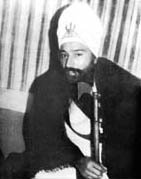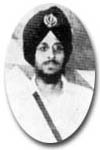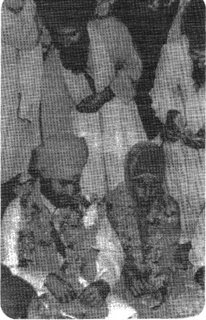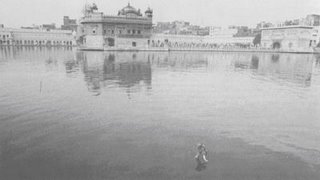Fearless Khalsa

Dear Father,
You made me realize that deep inside is where I will find to be Fearless.
You made me realize that I could get through whatever the world throws at me.
I am Fearless
Thanks to You
I can look evil in the eye
And say
As the Daughter of the Fearless
As the Daughter of the Khalsa
I am here to strike down evil with my Sword
I am here to strike down evil with my Five Gifts
I am here to strike down evil with the power instilled in me by my Father

Why did Sri Guru Gobind Singh Ji make his Sikh drink the Amrit of a Khanda. Why not a kirpan? Why not of anything else? In Sanskrit, Khanda means DEATH (mauth). KHANDA. Sri Guru Gobind Singh Ji mixed this with water and gave it to his Sikh to drink. The Sikh has mixed Death in water and swallowed it altogether (Sikh mauth noo ghol kay pee gya). Anybody can come up to a Sikh and say, 'Hey, I will hurt you, I will get you,'' and the Sikh will say,
"...I've already drank death from a bowl...What can you do to me?!?!..."
- Bhai Balbir Singh Ji (Ragi), during a keertan darbar on the Shaheedi Divas of Jathedar Akali Nihang Baba Deep Singh Jee Amar Khalsa Shaheed, November, 1984 (Paraphrased & Translated from Punjabi)
Pictures: Different Sikh Blogs
Poem: Anonymous Kaur
Source Bhai Balbir Singh Ji: BC Sikh Youth
Bibi Ravinder Kaur Jee...
 Ravinder Kaur was only nine, innocent but resolute. "I will also become Ammritdhari", "I,am going to join the Khalsa Fauj", "I want to be like my sister", such were her everyday declarations. Her elder brother and sister were already Amritdhari and a source of constant inspiration. The children would go to the Gurdwara together and join other Gursikhs in seva. Baba Kartaar Singh Jee and jatha used to visit a nearby village, every year for a week long program of Gurbanee Keertan & Katha Vichaar in memory of Sahibzade's (Guru Gobind Singh Jee's sons) Shaheedees. They would also hold Amrit Sanchaar (Baptism Ceremony). Ravinder Kaur's parents were not Amritdharee, nor did they wish for any of their children to take Amrit before their marriages. But this did not deter her in quest for Amrit. She traveled to the village alone and made herself present at the Amrit Sanchaar. Usually an adult accompanies a young child that is taking Amrit, but she knew that none of her family would help her in this situation. When the five beloved ones saw such a young girl on her own, they questioned her:
Ravinder Kaur was only nine, innocent but resolute. "I will also become Ammritdhari", "I,am going to join the Khalsa Fauj", "I want to be like my sister", such were her everyday declarations. Her elder brother and sister were already Amritdhari and a source of constant inspiration. The children would go to the Gurdwara together and join other Gursikhs in seva. Baba Kartaar Singh Jee and jatha used to visit a nearby village, every year for a week long program of Gurbanee Keertan & Katha Vichaar in memory of Sahibzade's (Guru Gobind Singh Jee's sons) Shaheedees. They would also hold Amrit Sanchaar (Baptism Ceremony). Ravinder Kaur's parents were not Amritdharee, nor did they wish for any of their children to take Amrit before their marriages. But this did not deter her in quest for Amrit. She traveled to the village alone and made herself present at the Amrit Sanchaar. Usually an adult accompanies a young child that is taking Amrit, but she knew that none of her family would help her in this situation. When the five beloved ones saw such a young girl on her own, they questioned her:
Panj: Who are you here with?
RK: I am on my own.
Panj: You are too young to take Amrit on your own. It is not an easy task to keep the responsibilities of Amrit. You are too young, come back when you are older.
RK: I don't understand. Guru Gobind Singh Jee's sons were also very young when they sacrificed their lives. If they can do it, then why can't I?
The Panj Pyare were stunned at the responses from this valiant child. There was no turning her back. She was blessed with Ammrit and so began her life as a servant of the Khalsa Panth.
Guru is our owner
Ravinder Kaur was youngest of six children, three sisters and 2 brothers, who called her "Rano". On her return from the Amrit Sanchaar, she was so excited she grabbed her harmonium and started doing keertan on their lawn. When her father arrived home from his work in the fields he could see what she had done, as she was now wearing keskee. He was enraged that his daughter had disobeyed his orders and started to shout at her. "Two of my children had already disobeyed me and now you've joined them? Why did you do this despite my forbidding?" he inquired. Rano was unperturbed and shot back with a question of her own:
RK: How many dogs roam around our village that have no owner?
Dad: How do I know? What kind of stupid question is that? I don't count the number of dogs in this village.
RK: Without Amrit we are like those dogs with no owners. Once we take Amrit, we are owned by Guru. We become his. When a dog without an owner dies, no-one cares and no-one knows where it goes after death. I know that with Guru Sahib's Amrit I belong to him and when I die he will be there for me. The kirpan belt (Gatra) we wear, is like Guru Sahib's leash on us.
Her father realized debating with Rano anymore was pointless. From the day she took Amrit, she had true love for Guru and Sikhi. She practiced the life of a true Gursikh, She would read Gurbani all day. People, even her own family were afraid of her. She always used to say,
"I hope that one day I will be lucky enough to give shaheedee".
 Incident with Bhai Fauja Singh Jee and Bhai Kewal Singh Jee
Incident with Bhai Fauja Singh Jee and Bhai Kewal Singh Jee
During those times Sikhs were suffering much oppression at the hands of the Indian government. The stories of police excesses did not scare Rano. The more injustices she heard of the more valiant she became in her fight for Sikhi.
Bhai Fauja Singh Jee and Bhai Kewal Singh Jee used to visit her village where she was fortunate enough to meet with them often. She was influenced by Bhai Fauja Singh Jee's braveness and his constant thoughts of being ready to die for the Khalsa Panth. The 1978 saka in Amritsar shook the whole community, where these Singhs gave their lives for the Panth.
Rano didn't get upset or angry over their shaheedee.  Instead she began doing Ardaas asking for her own chance to give shaheedee for the Panth.
Instead she began doing Ardaas asking for her own chance to give shaheedee for the Panth.
She used to get up very early in the morning to take shower and then do nitnem. One morning she woke up and went to the bathroom but quickly came running back into her bed. She used to sleep with her elder sister Shindo, Her sister knew something was wrong with Rano as she came back to their bedroom too quickly to have bathed, and she never used to get back into bed after a bath, she would always do her Simran and prayers. So Shindo asked Rano what the problem was and why she came back to bed. Rano told her to go back to sleep and that she will tell her later in the day. Later that day, Shindo kept asking Rano what happened, but Rano wouldn't tell her. However, under Shindo's persistent questioning Rano finally relented. She described that when she went outside towards the bathroom, she saw Bhai Fauja Singh Jee and Bhai Kewal Singh Jee sitting on their house's boundary wall. They were very happy and said to her:
"Rano, the Panth needs Sikhs like you. Your time is close, be prepared to sacrifice this life of yours for the Khalsa Panth."
Rano was overjoyed that finally what she had been praying for her whole life would be coming true. "Shindo, the reason I was trying to keep this a secret was that I don't want anybody in the family to make a fuss. Just make parshaad for everyone in the village and do 'Jaikaarays'. No one is to cry after my shaheedee and if anyone does I will come after them in some form.". She knew how to get her point across! From that day on, she was a part of every Dharam Yudh Morcha.
She used to take a Jatha of ladies from villages to wherever they were needed. In protest of the unfair treatment of Sikhs, she with her Jatha laid down on the railway lines to stop oncoming trains. She had been sentenced to imprisonment on several occasions by the Punjab police, for helping the Sikhs in the Dharam Yudh Morcha.
She was never worried about herself or her life and was a motivational speaker. Later, she became a religious studies teacher at a Punjabi girl's high school in Taran Taaran where she was now living.
Fixing the Bad Boys
During her time as a teacher, once some of her students came to her and told her that there were a few men (20-25yrs old) who would harass them on their bus ride to school. Rano told the girls not to worry. The next day, when the bus arrived at the school, Rano was waiting at the stop. All the students left the bus and the bus was about to leave, but Rano stood in the middle of the road in front of the bus.
She told the bus driver to stop the bus. She got on the bus, and told those immoral men to step outside. Initially, the men ignored her and told her to get off and let them be on their way. She knew that they would react like this, but she had come prepared; she showed them her gun that she had been hiding under her clothes. At the sight of her gun the men jumped off the bus like chickens as Rano followed.
At the bus stop she hit the men with the back of her gun until they were bruised. By this time a crowd had gathered at the bus stop to see what the commotion was. She told the men that if they bothered or tried to flirt or even look in the direction of those girls again, she would kill them. She also told them, that if they had a problem with what she had said and done to them, or if they wanted to settle things at a later time, they could come to her house, and she gave them her address. Those men were so scared of her that they never even got on the same bus as the students again.
 Anand Karaj (Marriage)
Anand Karaj (Marriage)
Rano was of an extremely religious temperament. She had no desire to marry as she knew she would not be on this earth for much time so she wanted to use what little time she had in Seva & Simran. However, as she was doing seva alongside many different people in dangerous places, the Sangat decided it would be best for her to marry a tyaar-bar-tyaar amritdharee singh while continuing her seva of Khalsa Panth. So in May 1984 she had her Anand Karaj with Bhai Harbhajan Singh Jee. He was an amritdharee singh who was doing seva alongside Baba Jarnail Singh Jee, Bhindranwale, at the Golden Temple in Amritsar. Her marriage took place at Manjee Sahib, Amritsar with five other couples. This was the last marriage program that ever took place at Manjee Sahib, Amritsar.
Rano's other sister, Binder, was married to a Singh in the Indian Air Force and they had two sons. Binder and her family lived far from Amritsar at the time of Rano's marriage so couldn't make it in time for the Anand Karaj. But they were coming to visit her shortly after the wedding. Binder asked Rano, what kind of suits she wanted (as she was supposed to bring some for her at the wedding as part of the tradition). She replied by saying:
"I don't want any sort of fancy suits nor will I be able to wear them. If you have to give me something, then give me one of your sons so that I can use him in the Dharam Yudh and Khalsa Panth Seva."
Binder was scared and didn't want to give one of her young sons to die. She thought Rano was out of her mind. But Rano was not into these worldly material things and always gave importance to seva for Khalsa Panth.
Last Conversation with her husband
In June 1984, just two months after her wedding, Operation Blue Star began and Rano got her wish. A few days before the fighting started; Baba Jarnail Singh Jee told all the ladies to go back to their villages as they were needed to keep the Panth growing after this Morcha. Most left but Rano and four other bibian refused to go saying that they were going to fight alongside the Singhs. The fighting started with the Indian army throwing bombs with tear gas shells into the Golden Temple. Rano was given the responsibility to distribute onions to all the Singhs as the gas from the onions stopped the tear gas from taking effect. She was carrying onions in bags and strung together around her neck. When she came to her husband, he started smiling at her. She said to him:
"Harbhajan Singh, this is no time for laughing, THE time has finally come. Make sure you die here with honor. There is no other perfect place to die for the Khalsa Panth than at Sri Harminder Sahib Jee. Don't try and be clever and find a sneaky way out. Do not be a coward and go back alive from here."
They then said Fateh to each other and she moved on with her duty. These were her last words with her husband. This was the last time she was seen by anyone. She was not found after this incident. According to her husband, all the five bibian were caught and killed by Indian Army. But other people have said that they were caught and put into jail. To this day, only Vaheguroo knows what happened to her and the other bibian.
 Later on during the fighting, her husband ran out of ammunition and they had to surrender. All of them were told to stand in a line and were about to be shot when an army officer came by and asked that a few men were needed. The requirement was of a Granthee Singh and a Ragee Jatha in order to perform keertan at Darbaar Sahib. Bhai Harbhajan Singh Jee was picked out of the line to play tabla but the Singhs alongside him were killed. He explained that his wife, Rano, knew how he might not sacrifice himself for the Khalsa Panth and she warned him against this. Nonetheless, the Punjab police killed him two years later.
Later on during the fighting, her husband ran out of ammunition and they had to surrender. All of them were told to stand in a line and were about to be shot when an army officer came by and asked that a few men were needed. The requirement was of a Granthee Singh and a Ragee Jatha in order to perform keertan at Darbaar Sahib. Bhai Harbhajan Singh Jee was picked out of the line to play tabla but the Singhs alongside him were killed. He explained that his wife, Rano, knew how he might not sacrifice himself for the Khalsa Panth and she warned him against this. Nonetheless, the Punjab police killed him two years later.
This is how Bibi Ravinder Kaur Jee lived the true life of a Gursikh and finally died as a martyr doing seva of Khalsa Panth.
The Final Shaheed of the Chamkaur Battle

Sikh women are always known to have responded to the call of their duty. They have not allowed hardships and dangers to stand in the way of the performance of their moral obligations. Bibi Harsarn Kaur was one of these women who faced the odds to fulfill her obligations.
In the battle of Chamkaur, Sri Guru Gobind Singh Ji and 40 starving Singhs battle the Mughal army. The battle which took place in Chamkaur’s mud fort lasted 72 hours and saw the loss of many Mughal soldiers and also 36 of Sri Guru Gobind Singh ji’s companions along with the two Sahibzadas. Fighting an army of hundreds of thousands, Sri Guru Gobind Singh ji gave an exhibition of his battle skills. Guru ji, following the orders of the Panth Khalsa (in the form of the Punj Pyaaray) left the fort along with Bhai Daya Singh, Bhai Maan Singh and one other Singh, after giving his clothes to Bhai Sangat Singh Ji to wear. Only Bhai Sangat Singh Ji and Bhai Sant Singh fought the battle to its end. They too were martyred. Seeing Guru Ji’s clothes on Bhai Sangat Singh, the Mughals were ecstatic and taking him to be Sri Guru Gobind Singh Ji, cut off his head and took it to Delhi. In every village it was announced that Sri Guru Gobind Singh Ji had been killed, “Look here at his chopped off head! His family is also finished. His two sons were killed in the battle and the two younger ones will also die abandoned. The revolution has been crushed. No one should go to the Chamkaur Fort. No one should cremate the dead Singhs.”
In every village it was announced that Sri Guru Gobind Singh Ji had been killed, “Look here at his chopped off head! His family is also finished. His two sons were killed in the battle and the two younger ones will also die abandoned. The revolution has been crushed. No one should go to the Chamkaur Fort. No one should cremate the dead Singhs.”
A tight cordon was put around the Fort. As the soldiers were going from village to village making their announcement, the people were retreating in terror into their homes. However, in village Khroond, a Daughter of Sri Guru Gobind Singh Ji, Bibi Harsharan Kaur, asked for her mother’s permission to perform the final rites for the Shaheeds. Her old mother replied, “it is total darkness outside and soldiers are everywhere around the fort, how will you even go near?”
Hearing this, Kalgeedhar’s Lioness Daughter replied with resolve
“I will avoid the soldiers and perform the cremation, and if need be, I’ll fight and die.”
The mother gave her courage and hugged her Daughter and then explained the Maryada to follow for the cremation. After performing Ardaas, Bibi Harsharan Kaur left for the Chamkaur Fort.
The battlefield which saw iron smashing against iron, the bellows of elephants, the trotting of hooves and calls of “Kill! Capture!” was now totally silent and enveloped in complete darkness.
In such a situation, the 16 year old girl Bibi Harsharan Kaur avoided the guards and arrived at the Fort. She saw that bodies were lying everywhere and distinguishing between Sikh and Mughal was very difficult. She still had faith and began to find arms with Karas and torsos with Kachheras and heads with long Kesh. As she found a body, she would wipe the face of every Shaheed.
Both Sahibzadas and about 30 Shaheeds were found and then she began to collect wood. Fearing the approaching light of dawn, Bibi Harsharan Kaur worked very quickly and soon prepared a pyre. She then lit the fire.
Seeing the rising flames, the guards were shocked and advanced towards the pyre.
Bibi Harsharan Kaur was seen in the light of the flames sitting beside the pyre. She was quietly reciting Keertan Sohilaa.
The guards were shocked and confused as to how a lone woman could come into the fort on such a dark night. The guards asked in a loud voice, “Who are you?!”
Bibi jee: I am the Daughter of Sri Guru Gobind Singh Ji
Officer: What are you doing here?
Bibi Jee: I am cremating my Martyred Brothers.
Officer: Don’t you know about the order that coming here is a crime?
Bibi Jee: I know it.
Officer: Then why have you disobeyed that order?
Bibi Jee: The orders of a false king do not stand before the orders of the Sachay Patshah (True King)
Officer: Meaning
Bibi Jee: Meaning that I have respect for the Singhs in my heart and with the Guru’s grace I have done my duty. I don’t care about your King’s orders.
Hearing such stern answers from Bibi Harsharan Kaur, the infuriated Mughal soldiers attempted to capture her and attacked. Bibi jee grabbed her kirpaan and fought back with determination.
After killing and maiming many soldiers, Bibi Harsharan Kaur was injured and fell to the ground. The soldiers picked Bibi Harsharan Kaur up and threw her into the pyre, burning her alive.
The next day the cordon around the Fort was lifted because it was clear that the Sahibzadas and most of the Shaheed Singhs had been cremated. The ancestors of the Phulkiaan family, Rama and Triloka, then cremated whichever Singhs remained. The story of Bibi Harsharan Kaur reached Sri Guru Gobind Singh ji Mahaaraaj in Talvandee Sabo (Damdama Sahib).
Upon hearing of her Daughter’s martyrdom, the old mother thanked Akaal Purakh. She said, “My Daughter has proven herself worthy.” The story of the cremation of the Chamkaur Shaheeds will forever serve as a glowing star of inspiration for all Singhs and Singhnees.
[Note: another version of Bibi Harsharan Kaur’s Shaheedee tells us that she was pierced by a Mughal lance and then thrown into the fire].
Note: Images and Video Edited
Video Clips: Sada Chir Jeevo: A Saga of Seven Dreadful Nights
Important: The images portrayed as Bibi Harsharan Kaur do not reflect the physical appearance of her. The video, and pictures, are only there to portray the events of what may have happened to her. Not to show the description of Bibi Harsharan Kaur.
Source: Adapted from Mahinder Singh ChachraaRee in Soora December 1997
Translated by Admin www.tapoban.org

